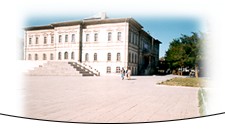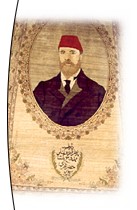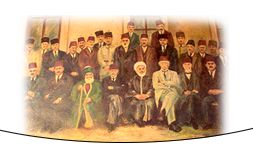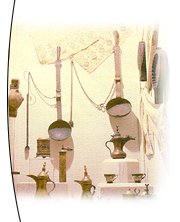Sivas - Congress Hall Atatürk and Ethnographical Museum
The building that was used as the “National Struggle Headquarters” between 2nd September - 18th December 1919 by the Representative Committee and Mustafa Kemal Atatürk, has an exceptional and important place within our Republic's history.
The four-line inscription which states that the building was built on 5th October 1892 by the Governor Mehmet Memduh Bey as a civilian school is now exhibited in the Sivas museum.
This building, which is an example of the 19th Century late Ottoman period civilian architecture, is three-storey and has an inner courtyard. Stone on the exterior facade and timber was the main material used in the construction of the building. 
The building that was assigned to Mustafa Kemal Atatürk and his friends for three and a half months as the headquarters; for “holding Sivas Congress meetings” for proving to whole world that the “national power of will and determination” was above of all the pressure, above of all personal or group governing, for organizing the “National Struggle movement in the Anatolia” and “foundation of the Republic,” received a historical identity.
Thirty two delegates representing nineteen provinces participated to the Sivas Congress. But due to delegates selected from other provinces and joined to the congress these numbers varied.
The building which functioned as a high school since it was constructed was respectively called Idadi, Sultani, Sivas Lisesi and Congress Lisesi (all meaning high school). With the alteration made on 1930 the entrance that was originally at the east was moved to the western facade and the roof was covered with sheet iron.
The building that was served as school until 1981, with the directives of the President Kenan Evren, it was planned to change into a museum. On 1984, the Congress building was handed over to the Ministry of Culture and Tourism. The General Directorate of the Antiquities and the Museums of our Ministry started its restoration the same year to change it into a museum. At the end of the restoration, display and arrangement works; the basement rearranged as to have warehouses, laboratory and photo shop, the ground floor arranged as Ethnographical museum and the top floor arranged as Atatürk and Congress museum.
 Between the dates 4 - 12 September 1919, the building's school hall, where Mustafa Kemal Atatürk and the Representative Committee used as the headquarters, held the Sivas Congress meetings.
Between the dates 4 - 12 September 1919, the building's school hall, where Mustafa Kemal Atatürk and the Representative Committee used as the headquarters, held the Sivas Congress meetings.
The historical Congress Hall and the study and rest room belonging to Atatürk are preserved as they were in those days.
In the above floor, a large room where pre-congress documents, the circulars and the notices of Mustafa Kemal Atatürk for the congress preparations were displayed. Also on the same floor, the most important thing of its time, the basis of the communications, the telegraph room; the room where the minutes of the congress are displayed; a large room where the announcements and the documents containing various news of the “Anatolian Women's Defence of the Country Society” that was established in Sivas and the copies of “The National Will” newspaper and its printing machine can be visited.
All the documents relating to decisions taken during and after the Sivas Congress; the copies of Atatürk’s special archives at the Presidential Palace, the special archive of the attache’s and the Military History Commission of the General Staff Headquarters and the archives of the Directorate of the Atatürk Research Centre are exhibited in the museum.
 The Ethnographical Works Section
The Ethnographical Works Section
The building that was built on 1892 by the Sivas Governor Memduh Pasha is one of the examples of the late 19th century civilian architecture of the Ottoman period. It is a three-storey building with an inner courtyard. Stone on the exterior facade and timber was the main material used in the construction. The building, which was a high school during the time used by Mustafa Kemal Atatürk and the Representative Committee, received a historical identity because of the Sivas Congress meeting held between 4 - 12 September.
The building was used again as a school until the year 1981. After repairing and reorganizing for exhibition, it was opened as a museum to visitors on 1990.
In the top floor, the Congress hall, the study and rest room of Atatürk are redecorated and kept as in the days of the congress.
In the same floor there are areas where documents related to congress that are exhibited.
The ground floor is completely separated for goods having ethnographical characteristics.
Armoury Section: Various war weapons such as swords, daggers, armours, helmets, shields, arrows, bows, matchlock rifles, pistols, flintlock rifles of the Ottoman period are exhibited in the armoury.
A. Turan Türkeroglu (Haci Beslen) Room: A separate room was given to Haci Beslen, who donated a collection of goods to the museum with ethnographical characteristics, coins, frames with calligraphical art examples, oil paintings.
Kilims Section: Kilims, prayer rugs and other small rug samples are displayed in this section. Also, the wooden minbar of the historical Divrigi Castle mosque, from the year 1180, is exhibited in this section.
Sivas Basodasi (guest room): The room where the guests are treated with respect in the Sivas mansions during the Ottoman time. It was redecorated with fireplace, embroidered curtains, sitting areas with divans, and cushions. Mannequins are also used in the display. Some wooden articles from the Ulu Mosque of Divrigi are also exhibited in this room.
Copper Articles Section: In this section articles of daily life from the Ottoman period are displayed. Such articles like large copper or brass trays, long-spouted pitchers, metal canteens, large copper dishes, cooking pans, skimmers, candle holders and some samples of fountain spouts, various weights of its time, locks, door knockers are some of the other articles that can be seen.
Dervish Lodge Articles Section: Some of the article of Dervish lodges such as flags, leather knifes, spits, prayer beads, candles, religious service beads, tambourines and bells are exhibited in this section.
Garments and Handworks: Various garments such as handkerchiefs, embroidered jackets and praying rugs, towels, bundles unique to Sivas region are exhibited in three different large rooms. Also, some wearing apparel are displayed to visitors on mannequins in the showcases placed in the middle of the rooms.
The centre courtyard of the museum building is arranged as the carpet section. The carpets of the Sivas region are displayed in chronological order.
 The fourteen windows situated in the corridor and looking to the courtyard were changed into shopwindows and in them coffee sets, silver jewelleries, hand written and calligraphical art works, glass and porcelain articles, lamps are exhibited.
The fourteen windows situated in the corridor and looking to the courtyard were changed into shopwindows and in them coffee sets, silver jewelleries, hand written and calligraphical art works, glass and porcelain articles, lamps are exhibited.
The owner of the building Mahmut Pasha’s hand woven portrait carpet from 1904 and the inscription informing the date the building was constructed, are articles worth of attention.
The “kangal” socks, hand woven carpet type pillowcases, donated to the museum by Prof. Dr. Sefik Dener are exhibited in a separate showcase. Also Gürün shawls form a separate article group.
Address: Across the Officer’s Club in Sivas.
Telephone: +90 (346) 221 04 46
Fax:+90 (346) 224 40 67